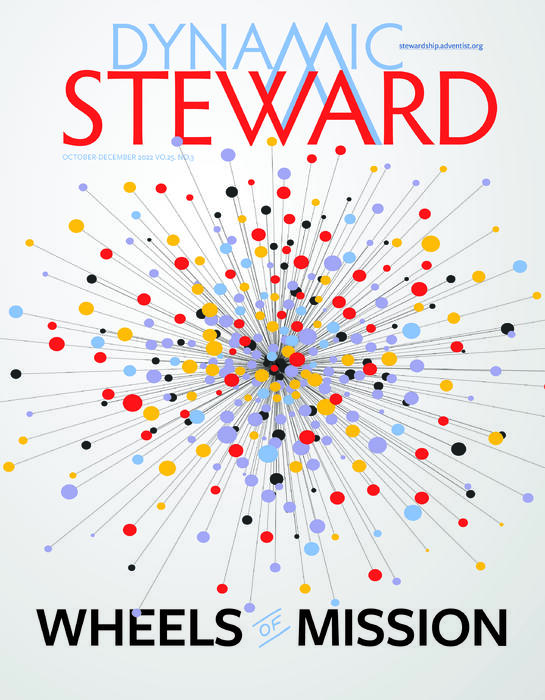Lead Measures—Adventist Stewardship Ministries
If you are in the middle of a huge parched land and someone announced: “You’ll find food and water over there,” his or her words would ignite hope and motivation. But unless the person shows you the way to reach the food and water, it won’t change much of your reality. This is how lead measures function. They are the highways to our aspired destination.
Many orientation documents, with inspiring vision, well-articulated mission, and clear goals, end, unfortunately, in a drawer or in an unopened computer file. Our greatest challenge as a church, or a department, is not planning and setting end goals (we are usually good at planning), but implementation. Lead measures, in a strategic document, act as facilitators of implementation.¹
The GC Stewardship Ministries’ Strategic Orientation document contains three lead measures that inform on how to grow a God-first culture in the church and society at large.
Lead Measure—Spiritual Empowerment
We read from the GC Stewardship Ministries’ Strategic Orientation document: Our first task is to make sure “members are nurtured spiritually, with a focus on the God First principle, through home visitations, weekly offertory devotionals, regular stewardship sermons, annual commitment ceremonies, and other relevant activities.”²
The first lead measure tells us that we nurture a God-first culture when we assist people to establish and grow a personal relationship with God. A God-first lifestyle is a spiritual venture, and it is groomed using spiritual means. This aligns with apostle Paul’s teachings: “Explaining spiritual realities with Spirit-taught words” (1 Corinthians 2:13). Stewardship leaders are spiritual leaders in essence.
The spiritual leadership model, proposed by Professor Louis Fry, a specialist in leadership, can help us understand how spiritual empowerment functions.3 His starting point, at the left of his model, is the inner life of the spiritual leader. Spiritual empowerment is the work of spiritual leaders, who themselves are spiritually empowered. While empowering others, they are in the process of cultivating their personal spiritual lives.
The second component of the model presents the three essential elements: hope/faith, vision, and altruistic love. These elements must translate into what we do and teach in stewardship ministries. We are called to share an inspiring vision about our identity as humans, created and redeemed as God’s stewards. This vision also embraces the idea that all are designed to partner in His mission. We communicate hope/faith by sharing the conviction that God’s grace transforms us into stewards, that we have already received what it takes to complete God’s final mission, and that God has rewards for the faithful. People experience altruistic love when we serve them with an unselfish spirit and share about the unconditional love of God for everyone. Our first concern is not people’s wallets, but their salvation and abundant life.
As a result of hope/faith, vision, and altruistic love, followers first acquire an assurance about their calling, a situation that brings meaning and purpose to one’s life. Secondly, they develop the conviction that they are valuable members of a body, creating a sense of belonging. Combined, a sense of calling and belonging are powerful sources of intrinsic motivation. They shape the choices and actions of people.
According to Fry’s model, the outcome of spiritual leadership/empowerment are individuals who are committed to the organization they belong to and the fulfillment of its mission. This is total member involvement! As an additional outcome, the recipient of spiritual empowerment enjoys a high level of personal life satisfaction.
Lead Measure—Stewardship Education for All
Our second lead measure is summarized in these words: “All segments of the church membership, including prospective members, should receive adequate training in regular and systematic giving, as well as their responsibility of supporting the local and worldwide mission equitably, . . . the management of personal finances, creation of wealth, and other relevant topics. Teachings will be based on the Bible, Ellen G. White’s book Counsels on Stewardship, and her other writings.”4
This second lead measure represents the bulk of what we do as stewardship leaders and educators. However, we often assume that an individual or a family knows about the lifestyle of a steward by simply growing up in the church or attending church for an extended period. This assumption can be faulty. “Normative ignorance” is a common phenomenon among church-attending Christians.5 This is particularly true for stewardship instructors. Unless we are intentional educators of all segments, many may not understand the implications of a God-first life. This resonates with the instruction of apostle Paul: “And how can they know who to trust if they haven’t heard of the One who can be trusted?” (Romans 10:14, The Message).6
The second segment of this lead measure aims at assisting a broader group, the community at large, to manage and create wealth. I’ll mention two examples, in support of this segment. Recently, while consulting the Global Tithe and Offerings Report for 2019, my attention was drawn to tithe per capita of several world divisions.7 Almost half of the divisions had a tithe per capita below $100. There are several good interpretations for these figures: 1) the adverse economic conditions prevailing in these territories, 2) a need for a membership audit, 3) an issue of unfaithfulness, and 4) many faithful members are earning very little to no income. Further studies may help to identify the exact cause for the low tithe per capita for each entity, but we wouldn’t be wrong to assume that it is often a mixture of causes. It appears that reason four is particularly true in places where the church is currently experiencing the highest growth. Unless we intentionally assist the church membership in the area of growing wealth, a large proportion of our faithful members won’t be able to partner or partner at a higher financial level in God’s final mission.
A second example is the current dire economic condition that many are facing today. Both inside and outside the church, individuals and families want to sharpen their skills to manage resources in order to cope more effectively with the prevailing adverse reality. This is the current felt need, and as other felt needs, it represents an entry point for the gospel. Financial literacy lessons that are Bible-based may eventually lead people to connect with Jesus, the Flawless Steward.
Lead Measure—Building Trust & Confidence
It is not advisable to have too many lead measures. The third lead measure is about creating a climate of trust and confidence: “Stewardship leaders encourage and work together with the leadership of the church to establish an internal control system, comply with the Use of Tithe Guidelines, assist in ensuring that regular financial information is provided to all members, and engage in other actions that contribute to building trust.”8
It is well-established that trust is an accelerator to partnership. The inspired words of Ellen White speak to the importance of this lead measure: “Those in responsible places are to act in such a way that the people will have firm confidence in them.”9 Unfortunately, when we consider that, worldwide, 1 out of 10 administrative entities are receiving an adverse or disclaimer audit report, we can legitimately admit that there is a need for improvement in this area of building trust and confidence.
A balanced approach is essential for the execution of this lead measure. While we constantly encourage the church leadership to demonstrate trustworthiness, it is our duty to invite the membership to remain faithful to God though any perception of unfaithfulness on the side of leadership. Our first reason for faithfulness is God’s unchanging faithfulness but not humans’ faithfulness which is not a constant.
Besides acting as highways and pathways to our goals, lead measures help us to measure progress. End goals inform us if we have reached the destination, lead measures, and their associated actions and initiatives, tell us if we are on the right track to the goal, and what are the needed corrective measures. An adapted version of the Stewardship Ministries Assessment Model Template may serve as a tool to track the execution of lead measures.10
Lead measures are our allies for a successful stewardship ministry at any level of the church. Prayerfully consider the three lead measures that are recommended here: spiritual empowerment, stewardship education for all, and building trust and confidence. Adapt, reformulate, or craft your own lead measures. Those who track their journey reach their destination.
1 Chris McChesney, Sean Covey, and Jim Huling, The 4 Disciplines of Execution: Achieving Your Wildly Important Goals (New York: Simon and Schuster, 2012).
² Adventist Stewardship Ministries, “Stewardship Ministries Strategic Orientation 2022–2025,” Stewardship Ministries, accessed October 17, 2022, https://stewardship.adventist.org/strategic-orient...(pdf).pdf.
3 Louis W. Fry, “Spiritual Leadership: State-of-the-Art and Future Directions for Theory, Research, and Practice,” in Spirituality in Business, ed. Jerry Biberman and Len Tischler (London: Palgrave Macmillan, 2008), 106–124.
4 Adventist Stewardship Ministries, “Stewardship Ministries Strategic Orientation 2022–2025.”
5 Christian Smith, Michael O. Emerson, and Patricia Snell. Passing the Plate: Why American Christians Don’t Give Away More Money (New York: Oxford University Press, 2008), Kindle.
6 Scripture quotations marked The Message are from The Message, copyright © 1993, 2002, 2018 by Eugene H. Peterson. Used by permission of NavPress Publishing Group. Represented by Tyndale House Publishers, Inc.
7 Archives, Statistics, and Research. Annual Statistical Report, vol. 2 (Silver Spring, MD: Office of Archives, Statistics, and Research, 2020), https://documents.adventistarchives.org/Statistics....
8 Adventist Stewardship Ministries, “Stewardship Ministries Strategic Orientation 2022–2025.”
9 Ellen G. White, Manuscript Releases, vol. 13 (Silver Spring, MD: Ellen G. White Estate, 1990), 198.
10 Adventist Stewardship Ministries, “Stewardship Ministries Assessment Model Template,” Stewardship Ministries, accessed October 17, 2022, https://stewardship.adventist.org/strategic-plan.


